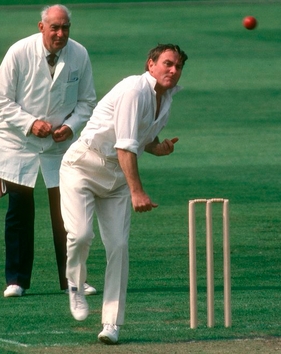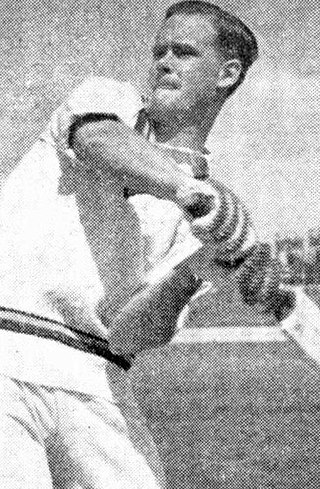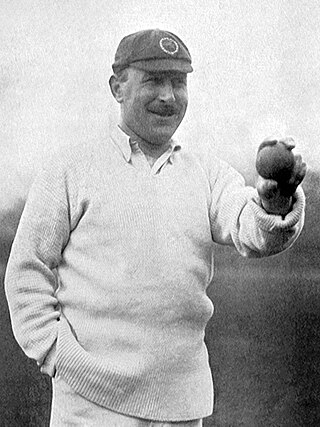John Augustine Snow is a retired English international cricketer who played for Sussex from 1961 to 1977 and represented England in 49 Test matches. He was born in Peopleton, Worcestershire.

Raymond Illingworth CBE was an English cricketer, cricket commentator and administrator. As of 2015, he was one of only nine players to have taken 2,000 wickets and made 20,000 runs in first-class cricket. He played for Yorkshire, Leicestershire (1969–1978) and England (1958–1973) and was a Wisden Cricketer of the Year in 1960.

Dennis Brian Close, was an English first-class cricketer. He was picked to play against New Zealand in July 1949, when he was 18 years old. Close went on to play 22 Test matches for England, captaining them seven times to six wins and one drawn test. Close also captained Yorkshire to four county championship titles – the main domestic trophy in English cricket. He later went on to captain Somerset, where he is widely credited with developing the county into a hard-playing team, and helping to mould Viv Richards and Ian Botham into the successful players they became.
Kenneth Higgs was an English fast-medium bowler, who was most successful as the opening partner to Brian Statham with Lancashire in the 1960s. He later played with success for Leicestershire.

Richard Keith Illingworth is an English former cricketer, who is currently an umpire. The bulk of his domestic cricketing career was with Worcestershire, although he had a spell with Derbyshire, and overseas with Natal. He played in nine Tests and twenty five ODIs for England, including participating in the 1992 and 1996 Cricket World Cups.

George Herbert Hirst was a professional English cricketer who played first-class cricket for Yorkshire County Cricket Club between 1891 and 1921, with a further appearance in 1929. One of the best all-rounders of his time, Hirst was a left arm medium-fast bowler and right-handed batsman. He played in 24 Test matches for England between 1897 and 1909, touring Australia twice. He completed the double of 1,000 runs and 100 wickets in an English cricket season 14 times, the second most of any cricketer after his contemporary and team-mate Wilfred Rhodes. One of the Wisden Cricketers of the Year for 1901, Hirst scored 36,356 runs and took 2,742 wickets in first-class cricket. In Tests, he made 790 runs and captured 59 wickets.

Robert William Taylor MBE is an English former cricketer who played as wicket-keeper for Derbyshire between 1961 and 1984 and for England between 1971 and 1984. He made 57 Test, and 639 first-class cricket appearances in total, taking 1,473 catches. The 2,069 victims across his entire career is the most of any wicket-keeper in first-class history. He is considered one of the world's most accomplished wicket-keepers. He made his first-class debut for Minor Counties against South Africa in 1960, having made his Staffordshire debut in 1958. He became Derbyshire's first choice wicket-keeper when George Dawkes sustained a career-ending injury. His final First Class appearance was at the Scarborough Festival in 1988. He remained first choice until his retirement except for a short period in 1964 when Laurie Johnson was tried as a batsman-wicketkeeper.

Arthur Dick Pougher was an English professional cricketer and umpire who played for Leicestershire County Cricket Club from 1885 to 1901, and in one Test match for England in 1891–92. He was born at Humberstone, Leicestershire and died at Aylestone Park, Leicester.
John Christopher Balderstone was an English professional in cricket and football, and one of the last sportsmen to combine both sports over a prolonged period. He played football as a midfielder for Huddersfield Town, Carlisle United, Doncaster Rovers and Queen of the South. He played and umpired in first-class cricket making it to international level – he played in two Tests in 1976 and umpired in two ODIs between 1994 to 1998. In a long club career, he was a key part of the five trophy winning Leicestershire side of the early and mid-1970s.
Geoffrey Alan Cope played first-class cricket for Yorkshire from 1966 to 1980, and appeared in three Test matches for England.
1947 was the 48th season of County Championship cricket in England. It is chiefly remembered for the batting performances of Denis Compton and Bill Edrich who established seasonal records that, with the subsequent reduction in the number of first-class matches, will probably never be broken. Their form was key to their team Middlesex winning the County Championship for the first time since 1921, although they were involved in a tight contest for the title with the eventual runners-up Gloucestershire, for whom Tom Goddard was the most outstanding bowler of the season. Compton and Edrich were assisted by the fact that it was the driest and sunniest English summer for a generation, ensuring plenty of good batting wickets.
Barry Dudleston is a former first-class cricketer and umpire. He was a right-handed batsman and occasional wicketkeeper who played cricket for Leicestershire, Gloucestershire and Rhodesia. By the end of his 295 first-class games career, he had made 14,747 runs at 32.48, with 32 hundreds and 241 wickets.
Jack van Geloven was an English first-class cricketer, who played three matches for Yorkshire County Cricket Club in 1955, and then joined Leicestershire on special registration for the 1956 season. He was a regular in the Leicestershire side for ten seasons and won his county cap in 1959.
Charles Terence Spencer was an English first-class cricketer who played for Leicestershire. Only Ewart Astill and George Geary have taken more wickets for Leicestershire. His career best figures of 9-63 were made in 1954 against Yorkshire. He is the nephew of Leicestershire fast bowler Haydon Smith.
Edward Philip Illingworth is a former Australian cricketer who played five first-class matches for Victoria between 1962 and 1964. A right-arm medium pace bowler, Illingworth was best remembered for being no-balled for throwing in a Sheffield Shield match against South Australia in November 1964 by umpires Col Egar and Jack Ryan. His selection for Victoria was made more controversial by the fact that he had been called at district level for throwing prior to his first-class debut. Away from first-class cricket, Illingworth had a successful career for Fitzroy in Victorian Premier Cricket, where he remains the eighth highest wicket-taker of all time, with 599. He was named the club champion three times, and later served for seven years as a board member of the Victorian Cricket Association.

Jack David Shantry is a former English cricketer who played county cricket for Worcestershire. He is now an umpire.

During the seven years 1933 to 1939, Herbert Sutcliffe played throughout the period for Yorkshire during one of the club's most successful phases. His Test career ended in 1935 but he formed a new opening partnership for Yorkshire with the young Len Hutton. In 1939, he was the first Yorkshire player to be called up for military service as the Second World War loomed.
John Scholes Savage was an English cricketer who played first-class and List A cricket for Leicestershire and Lancashire between 1953 and 1969. He was born at Ramsbottom, Lancashire and died at Rochdale.
Bernard Cromack is a former English cricketer who played first-class cricket for Leicestershire between 1959 and 1961, reappearing in a single match in 1968. He was a right-handed lower-order batsman and a left-arm orthodox spin bowler. He was born at Rothwell in Yorkshire.

The 2020 Bob Willis Trophy was a first-class cricket tournament held in the 2020 English cricket season, and the inaugural edition of the Bob Willis Trophy. It was separate from the County Championship, which was not held in 2020 due to the impact of the COVID-19 pandemic in the United Kingdom. The eighteen county cricket teams were split into three regional groups of six, with the two group winners with the most points advancing to a final held at Lord's. The maximum number of overs bowled in a day was reduced from 96 to 90, and the team's first innings could be no longer than 120 overs.








